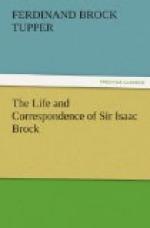The surrender of Detroit was so unexpected, that it produced an almost electrical effect throughout the Canadas: it was the first enterprize in which the militia had been engaged, and its success not only imparted confidence to that body, but it inspired the timid, fixed the wavering, and awed the disaffected. Major-General Brock from this moment became the idol of the great mass of those whom he governed; and when he returned to York, whither he arrived on the 27th of August, he was received amidst the heartfelt acclamations of a grateful people, rescued by his promptitude from the ignominy of submitting to a conqueror. They remembered that in the short space of nineteen days he had, not only met the legislature and settled the public business of the province under the most trying circumstances that a commander could encounter, but, with means incredibly limited, he had gone nearly 300 miles in pursuit of an invading enemy of almost double his own force and compelled him to surrender, thus extending the British dominion without bloodshed over an extent of country almost equal to Upper Canada.[71]
The conduct of the American general in so tamely surrendering is inexplicable, as Detroit contained an ample supply of ammunition and provisions for nearly a month, besides an abundance of wheat in the territory, with mills to grind any quantity into flour. One of his officers, Colonel Cass, in a long letter to the Honorable William Eustis, the secretary of war at Washington, said: “I have been informed by Colonel Findley, who saw the return of the quartermaster-general the day after the surrender, that their whole force, of every description, white, red, and black, was 1,030.[72] They had twenty-nine platoons, twelve in a platoon, of men dressed in uniform. Many of these were evidently Canadian militia. The rest of their militia increased their white force to about 700. The number of Indians could not be ascertained with any degree of precision—not many were visible. And in the event of an attack upon the town and fort, it was a species of force which could have afforded no material advantage to the enemy.... That we were far superior to the enemy, that upon any ordinary principles of calculation we would have defeated them, the wounded and indignant feelings of every man there will testify.... I was informed by General Hull, the morning after the capitulation, that the British forces consisted of 1,800 regulars, and that he surrendered to prevent the effusion of human blood. That he magnified their regular force nearly five-fold, there can be no doubt. Whether the philanthropic reason assigned by him is a sufficient justification for surrendering a fortified town, an army, and a territory, is for the government to determine. Confident I am, that had the courage and conduct of the general been equal to the spirit and zeal of the troops, the event would have been brilliant and successful as it is now disastrous and dishonorable.”




